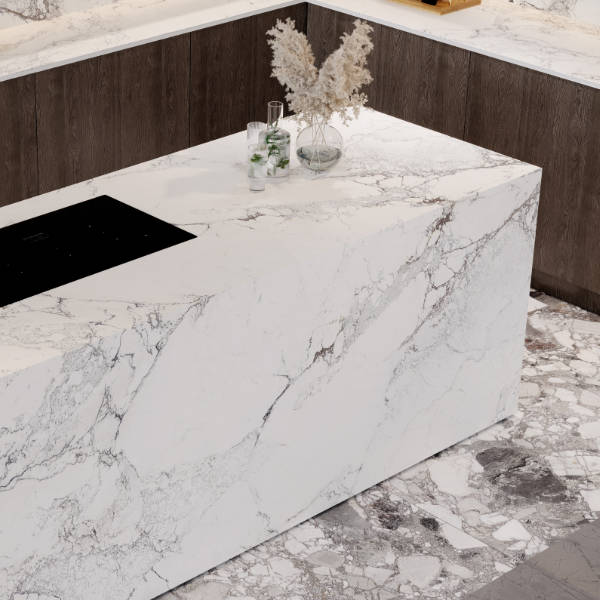Logistics
The floor sets the tempo for the whole kitchen. Black and white porcelain tiles bring order, clarity, and an ease that suits both shaker joinery and pared-back contemporary cabinetry. Monochrome works well in busy homes, reads cleanly under both natural and artificial light, and provides a disciplined backdrop for metalwork, timber, and stone.
When styling kitchens with black and white porcelain tiles, start by considering the light, circulation routes, and the mood you want to create underfoot. Use a softly textured white to keep glare in check, introduce black as a measured border or a checkerboard where you want definition, and let grout tone fine-tune the contrast. The result is calm, practical, and quietly confident. Here’s the guide on the best way to ensure your kitchen is cohesive, stress-free, and most importantly, reflects you.
Begin with a Clear Brief
Start by noting how the kitchen is used throughout the day. Morning light, family routines, and circulation routes all inform the tile choice. Decide whether the floor should recede softly or contribute a measured pattern, and consider how it will relate to adjoining rooms. If you favour a seamless look, a pale field tile with gentle texture keeps reflections in check and lets joinery and timber breathe. If you want definition, introduce black in a way that supports, rather than dominates, the plan.
Grout and Edges
Grout is part of the composition. A soft grey reduces contrast and is practical for family life, while near white keeps a seamless look around pale tiles. For checkerboard layouts, matching grout to the lighter tile often helps the eye read the pattern cleanly. Discuss rectified edges and joint width with your installer, as tight joints demand a level, stable substrate. Agree on a set-out that centres key views, aligns through doorways, and balances perimeter cuts, then dry-lay a test area to confirm the plan. If you are leaning towards a gentle, low-sheen white field tile, the shaped surface of something like the Divine Glacier tile diffuses glare and keeps the grid calm under both natural and artificial light.
Finish and texture
Surface finish sets the mood and influences maintenance. A shaped or lightly textured white tile introduces soft shadow and diffuses glare, especially in rooms with strong daylight. This keeps large areas gentle rather than glossy, and it pairs well with both cool marbles and warm oaks. Black tiles benefit from a low-sheen, velvety finish that minimises footprints and lends depth. Avoid high-polish combinations that can feel stark in a domestic setting, and always view samples in natural and artificial light to confirm that tones hold steady through the day.
Cabinetry, Worktops, and Colour
Monochrome floors reward restraint above the waistline. Timber fronts in oak or walnut bring warmth and settle the palette, while painted cabinetry in chalky white or deep charcoal feels composed against a tiled grid. If you prefer colour, choose earthy green, inky blue, or muted purple, and echo it in stools, textiles, or accents. Worktops in honed marble, softly textured porcelain, or a quiet quartz vein complement black and white porcelain tiles without competing. For a touch of heritage character within a modern plan, the Black and White Clarity tile sits beautifully with cup pulls, shaker doors, and aged brass, softening edges while keeping the overall read disciplined.
Thresholds and Continuity
Think carefully about how the kitchen floor meets neighbouring rooms and exterior terraces. Continuing the same tile, format, and joint through connected areas creates easy flow, provided levels are coordinated. Where a change is needed, a border or a single course of black can form a tidy, intentional threshold. Align grids across doorways wherever practical – the effect is quietly architectural and makes the whole layout feel resolved.
Practicality
One of the chief advantages of black and white porcelain tiles is durability. Porcelain is dense, water-resistant, and straightforward to maintain with a gentle cleaner. It partners naturally with underfloor heating, delivering even warmth that enhances the tactile quality of low-sheen finishes. In high-traffic routes, a lightly textured surface helps disguise day-to-day dust and footprints. Near entrances, a mat well is invaluable, and a marginally deeper grout tone will keep things composed between cleans. Where a grounded, design-led black is required, the Provence Vintage Ceramic tile adds depth and definition without tipping the scheme heavy.
Ready to Plan Your Kitchen Floor?
If you are styling kitchens with black and white porcelain tiles and want a confident, long-lasting result, we can help with finish and format recommendations, pattern planning, set-out, and practical specification. For local customers, visit our showroom to see swatches and get a feel for the tiles that are right for you. For customers further afield, call us on 01435 512 301 and we’ll help you over the phone.

